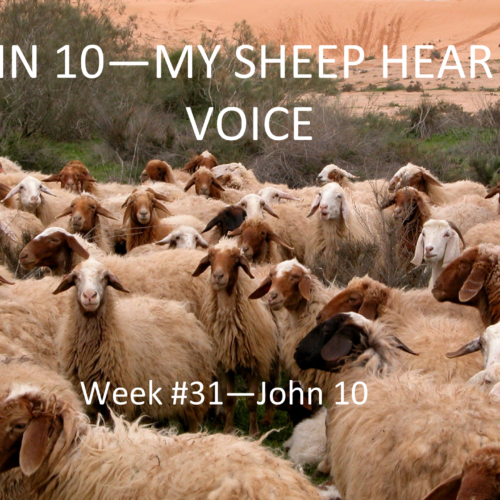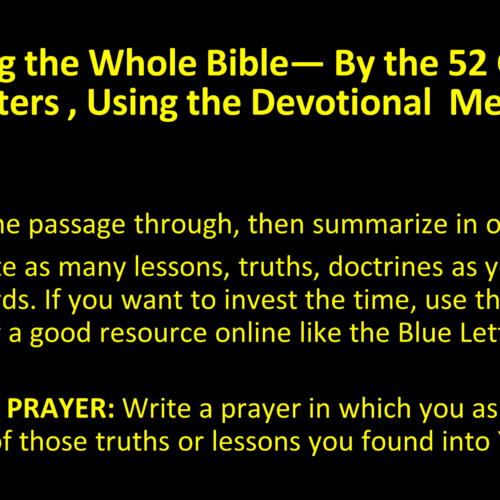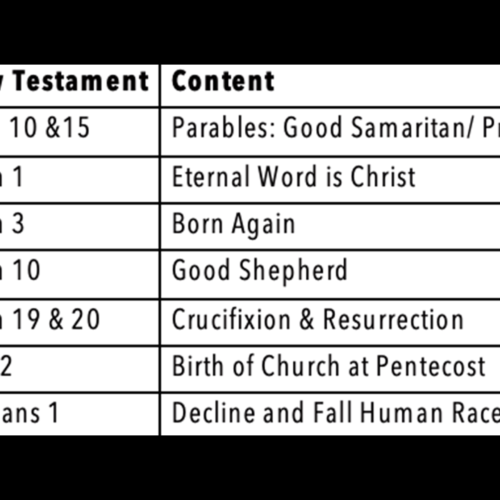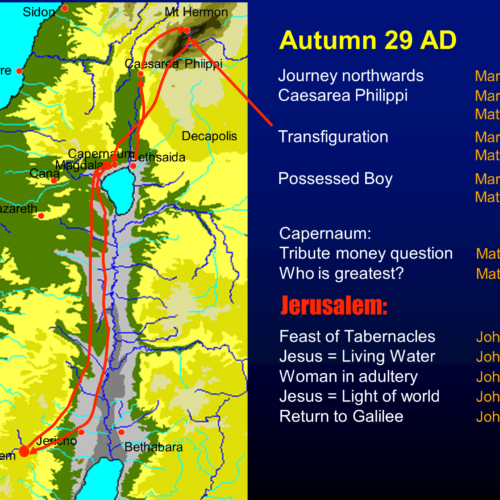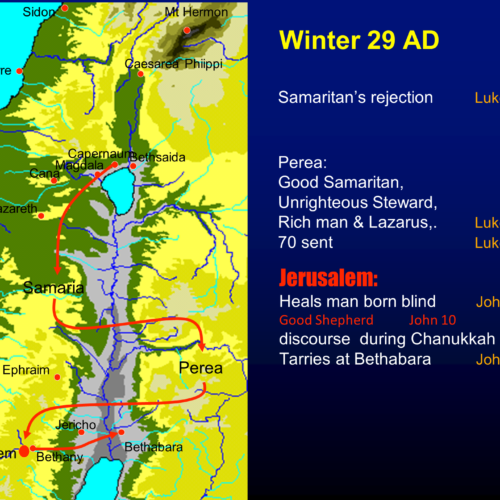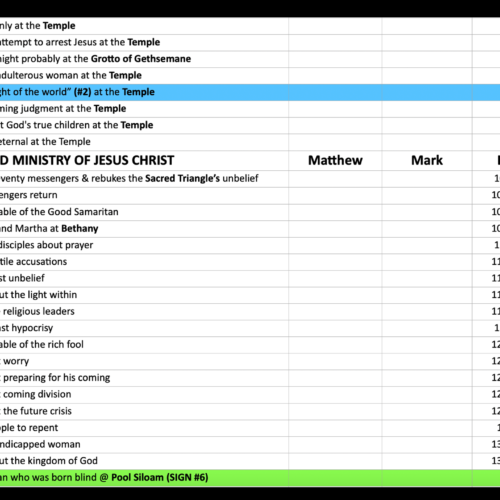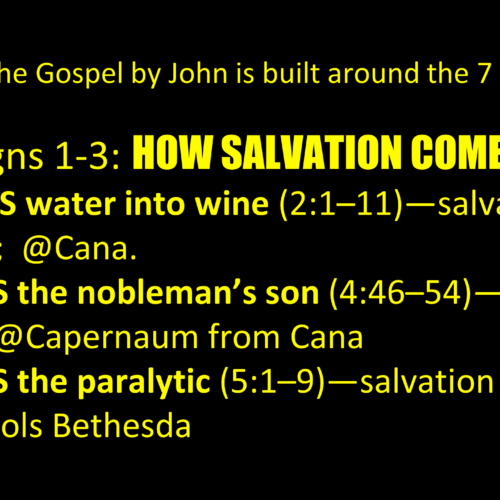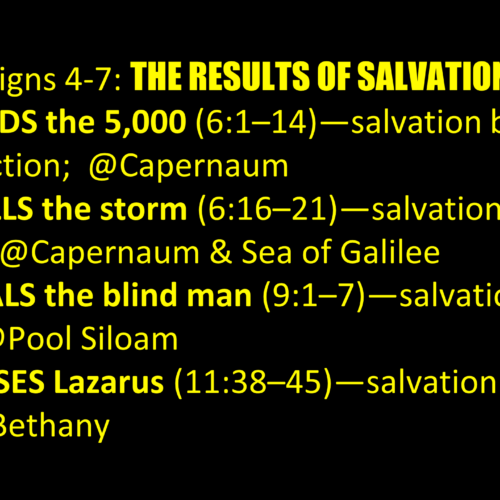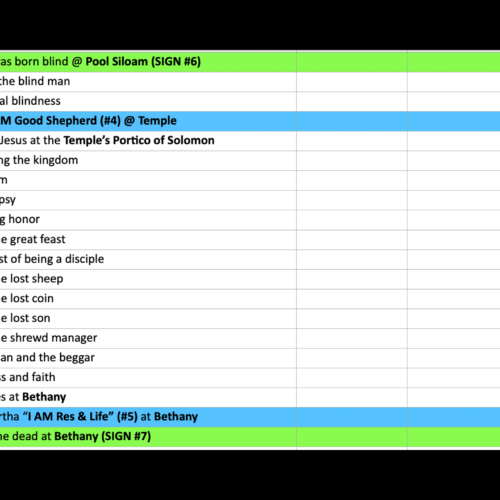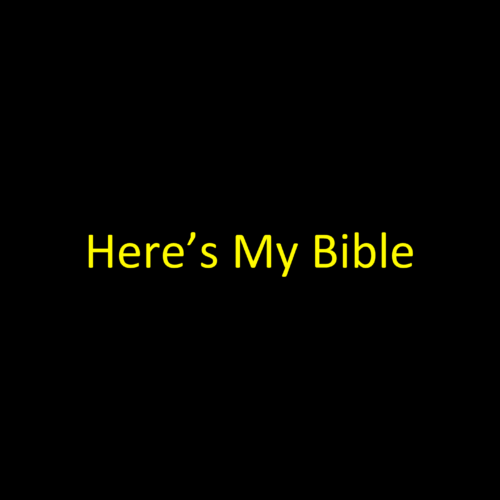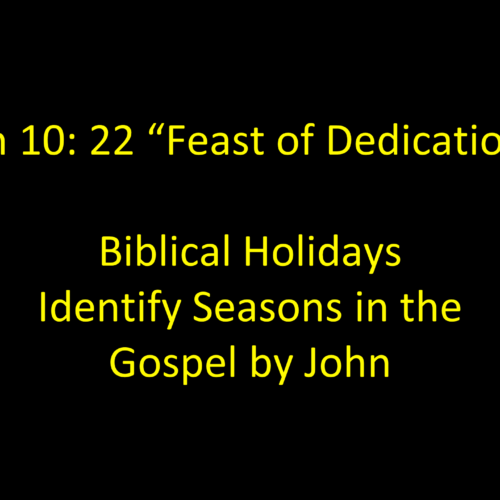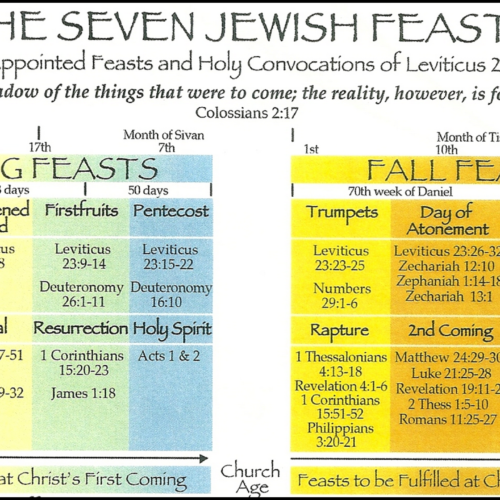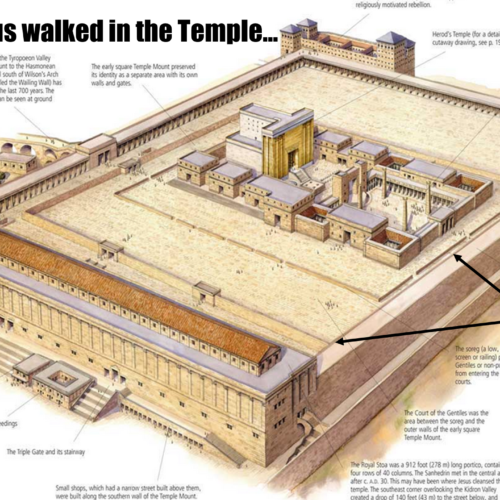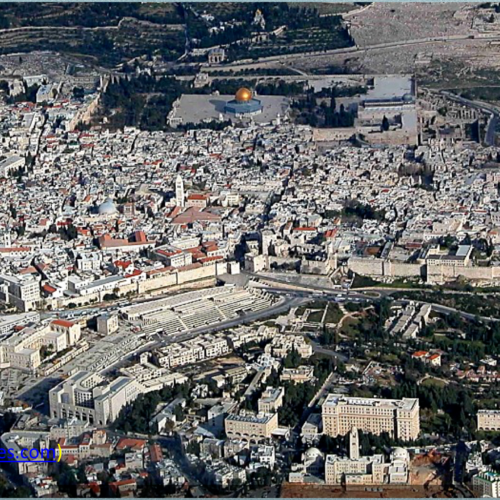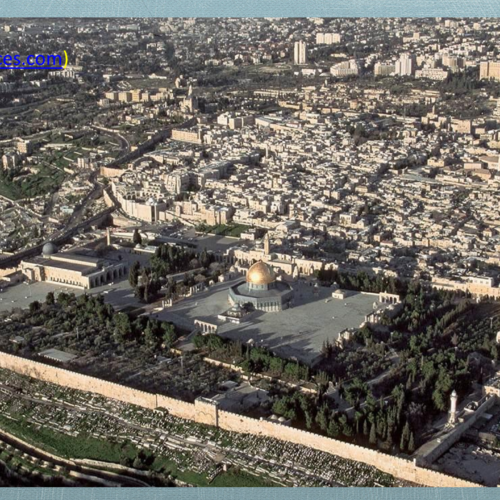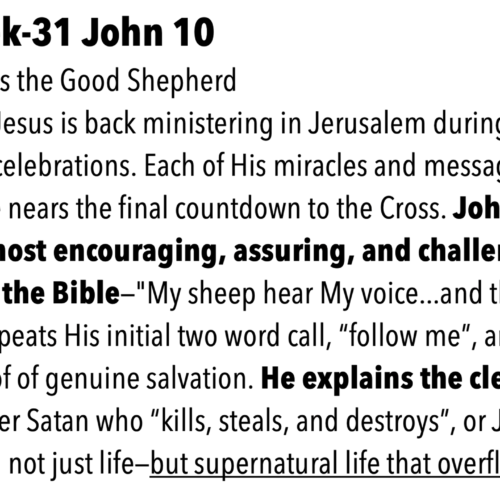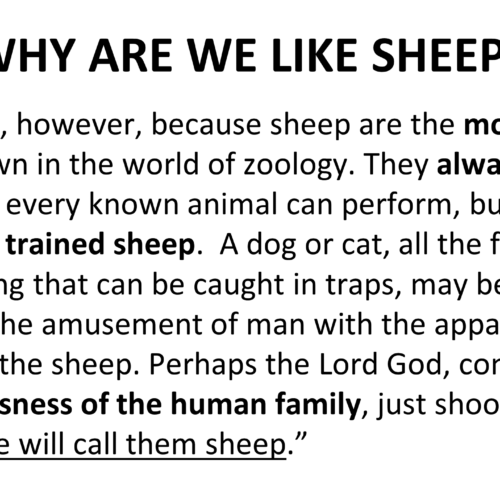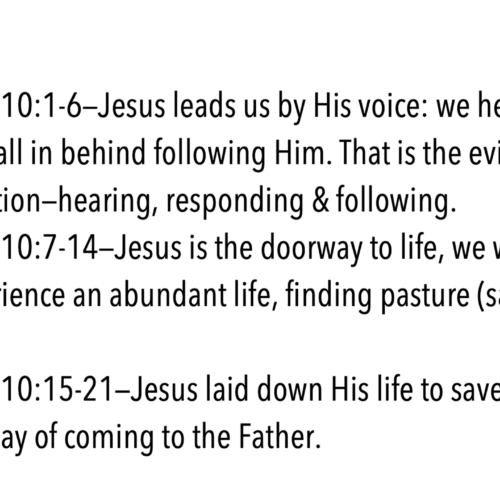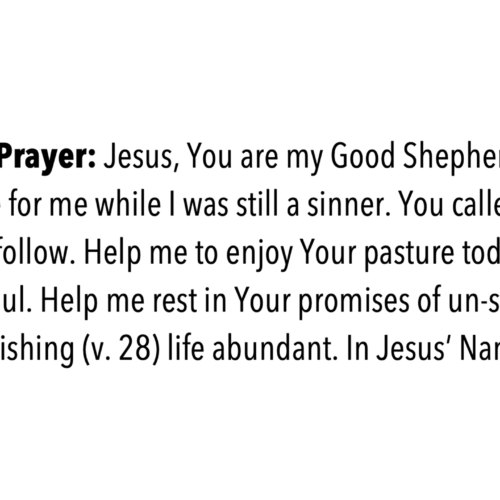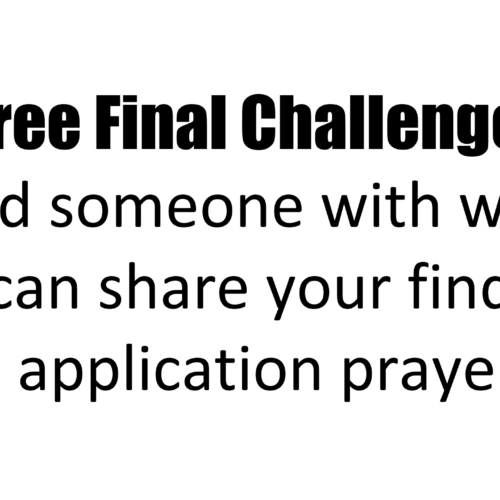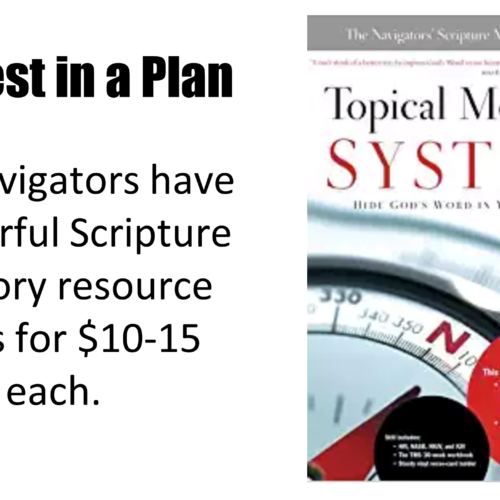If the YouTube video above is not available, here are two other ways to view:
Hear The Voice Of God
FTGC-31
210801AM
Transcript
John Barnett here. Welcome to our small group Bible study. As I was preparing for John chapter 10, I was thinking back over the last five years out of all the years I’ve led this with small groups. I really love this chapter. I hope that after I get done showing you all the wonders that the Lord has packed into the 10th chapter of the Gospel by John, it’ll become one of your favorite chapters of all the chapters of the Bible. There are 1,189 chapters and we’ve summarized the whole Bible by these 52 chapters or passages. Like the Sermon on the Mount, we did a few weeks back. it is three chapters, but it’s a unit. I put either single chapters or multiple chapters when they’re part of a unit. John 10 is unique and we’re going to spend most of the time actually over here in my Bible.
What I want you to think about is coming to Panera or Starbucks or Chipotle. Those are the three places that I’ve led this study over and over again. When we’d come, of course, we’d always bring our Bible and our notebook because part of this is showing what you’ve learned with the other members of the group. When we get together, we always show what we learned from the last week of study. With you, what I’m doing is I’m showing you what I’ve found and launching you to look for all those things this week. There are two ways you could use this in your life. Either you could get a small group together where you study, find, discover, write things down, and learn. You could become the leader of a small group and do what I do. You spend the whole week learning this and then you show it to them. You actually lead them and teach them. Both of those methods are powerful. The goal of this is to personally be in the word of God and to personally be allowing the word of God to change me. That’s what John 17:17 says, a few chapters to the right of where we are, “Sanctify them by Your truth. Your word is truth.” The more I am exposed to the truth the more the word of God changes me. So, either way.
This is what I want you to imagine. I want you to imagine I’m sitting across from you at this table. I am showing you how to find all these things, what to look for in your Bible. On this slide, it says “My sheep, hear My voice.” This is our 31st week together of the 52 weeks and boy is this year going by fast. COVID is waning. The variants are rising. The temperature is rising. All these records are being broken, but this is what we’re in. We’re surveying the whole Bible. Each time we study any chapter we have the weight of the whole Bible pushing down on that text. Do you remember I drew in one of the classes a pyramid inverted with the point going down? Whatever text we are studying has the weight of the whole Bible pushing down on that text. That’s how we let the Bible explain the Bible.
We’re looking at the whole Bible by the 52 Greatest Chapters or passages. I know some of you are jumping in and this might be your very first time. Welcome to our study. We’ve been going for eight months, but welcome. You can stay with us so you’re exploring with us as we go and then circle around and start back with whatever you’ve missed. We’re using a devotional method. What we do is find a title we invent, let me look in my journal, John 10, right there is where I’ve been working all week long. I wrote Jesus the Door of Life. That’s one day. Remember I work on this every day. The next day, when I studied, I put The Good Shepherd. That was my summary of the whole 10th chapter. The next time I wrote Hearing and Following Jesus. Really, “My sheep hear My voice.” All that really resonated with me. It was just a good week and I hope it is for you.
Then you write down in your journal and you really need to write these things down as you find them. Don’t try and make this like a term paper that has to be flawless according to the rules of style for research papers. No, this is your personal journal of what you’re finding. It’s many lessons. That’s why I work on it every day. I find more lessons some days than others. This morning, I was out early again, and it just was beautiful. I just rehearsed everything that I’d found. As you study, write down as your lessons as many truths, as many doctrines, as you can find. Then I encourage you if you want to invest the time to use a study Bible. All of you that are tracking with us right here is the MacArthur Study Bible. Let me get to chapter 10. Chapter 10 has 1, 2, 3, 4, 5, columns of footnotes. Amazing. This is like going to Bible college. What I’m doing is I’m giving you the big group lecture in the lecture hall and then launching you to the research and these are your tools.
Here’s the highlight. We do our application prayer. This is where we are. We’re on week 31, the Good Shepherd. Last week, we looked at Nicodemus and the serpent on the pole. Then we introduced the Gospel by John. Before that, we were looking at the whole parabolic teaching of Christ and the Good Samaritan, the prodigal son. Next week, whoa, the heart of the Gospel. Christ died for our sins, according to the scripture, then He was buried, then He rose again. All of that is what we’re covering, the Gospel of Jesus Christ and His crucifixion, His resurrection. The week after that is the birth of the church at Pentecost. The implications of Pentecost and what the church is and what happened and what were all those languages. Then the week after that, wow, Romans with the decline and fall of the human race. Aren’t we seeing that with the behavior going on in our world and the behavior going on in our country? You see the decline and fall of the human race.
Let me give you this animated map and show you how we can see the background and understand the context. To properly interpret the Bible you have to understand to whom God was speaking when He wrote those words. Almost all of the scriptures are letters, or epistles they’re called, or they’re narratives of records that God gave at certain times to certain groups of people. Paul explains to us that all scripture is given by the inspiration of God, so it’s all inspired. All of scripture is profitable for four things: doctrine, reproof, correction, instruction in righteousness.
Doctrine is what’s right. Not what I think is right, what God says is right. Reproof is what’s wrong. God tells us what’s right and what’s wrong. Culture doesn’t decide that and neither does public policy, public opinion, social media, whatever’s currently trending. No, doctrine and reproof are what’s right and what’s wrong. Correction, how to get right, and instruction in righteousness, I’m quoting 2 Timothy 3, 16, and 17. Instruction in righteousness is how to stay right. What’s wrong, what’s right, how to get right, how to stay right. Those are the four purposes of scripture.
The context is determined by the history and the geography, what the rest of the Bible says, the meaning of the words, all of those are pieces. That is why a study Bible is so helpful, especially when you read the Gospel by John. There’s a whole two page introduction to this book, telling the author, the audience, the time period, everything.
Here’s our animated map. We’re in the Autumn of 29 AD. Jesus is journeying northwards. Do you see where He went from Bethsaida up to Caesarea Philippi in the north? He goes for the transfiguration up here in Mount Hermon. Then He goes down from the mountain and the disciples had this demonized boy and He heals him. Then Jesus goes back, see here, to Capernaum. That’s His home base right there. Then, this is why I want to show this to you. Jesus goes down here to Jerusalem, see there’s the top of the Dead Sea. Here’s the Sea of Galilee where His base was. 2/3rds of Christ’s ministry was up here and the other third is scattered everywhere else. When He’s in Jerusalem, big things happen.
Look at the events. He’s there at the Feast of Tabernacles. That tells us that He goes down there in October because the Feast of Tabernacles is always in October. We have a timestamp and Jesus gives His discourse on the living water. The woman taken in adultery is dumped in front of Him. He uses that as an opportunity to teach I am the light of the world, and He goes back to Galilee. Watch, He’s on His way back down as He’s coming for the next round of feasts. He has gone to the whole Tabernacles time period and now He’s going in the Winter to the next feast. He goes through Samaria, He’s rejected. He goes into Perea. He tells all those famous parables that we covered a few weeks back, then He gets to Jerusalem. He heals a man born blind and we’ll talk about that. There we are, that’s chapter 10.
Chapter 10 follows with this rejection, all of this parabolic teaching, missions, He sent the 70 out, and this sign miracle right here. Remember the whole book of John is built around seven signs. That’s what it says in John chapter 20 verses 30 and 31. He said many other things were written, which would fill the whole world, “but these are written that you might believe that Jesus Christ is the Son of God, and that believing you may have life through His name.” We’ll talk about that more later. Notice this was during Hanukkah and then Jesus tarries at Bethabara.
Let’s look at this chart, it’s on our website discoverthebook.org and it’s called the 250 Plus Events of the Life of Christ. Remember they’re numbered down the side and they’re chronologically appearing, showing what book of the Bible they’re in. Do you notice that what I showed you on the map, the I Am the light of the world, was at the temple? That’s only in the Gospel by John. The sending out of the 70, that’s only in Luke. Look where John picks up, right here, the six of seven signs and that’s the man born blind at the Pool of Siloam, that’s chapter 9.
Do you remember the sign miracles? It says in chapter 9, let me get over here and show you my Bible. Right here in chapter 9 at the top, I wrote sign number six, blind man healed at Siloam. Each of Christ’s signs teaches us something and here it teaches salvation opens our eyes to see. That’s chapter 9 and it’s at the Pool of Siloam right there. The key is right here in verse 16. “Therefore some of the Pharisees said, ‘This Man is not from God, because He doesn’t keep the Sabbath.’ Others said, ‘How can a man who’s a sinner'” look at this, “‘do such signs?'” I wrote number six because this is the sixth time Jesus shows one of these amazing signs.
Back at the slides you can see the Gospel of John is built around the seven signs, remember I referred you to John chapter 20. The first three, remind us how we get saved, how salvation comes to us. Jesus turned the water into wine in chapter 2, so salvation is miraculous. He did that at Cana of Galilee. Healing the nobleman’s son, that’s John 4, 46 to 54, shows salvation is by faith. He did that at Capernaum. Healing the nobleman’s son who came to Jesus in Cana, which was quite a distance from Capernaum. Jesus heals the son in Capernaum while being in Canaan showing great power. He heals the paralytic by the pools of Bethesda.
The next four, four through seven of the seven signs, aren’t how salvation comes to us, they are what salvation does. Salvation comes by faith at some miracle and it’s by grace. Totally God’s gracious offer, but what does it do to us? The feeding of the 5,000 in chapter 6, shows that salvation brings satisfaction. Nobody was hungry when Jesus got done, they were satisfied. He did that at Capernaum. Stilling the storm, also in chapter 6, shows salvation brings peace from our troubled sea. Remember Isaiah said that salvation means that we, who were like the restless sea washing up foam and junk, become peaceful. Remember the work of righteousness is peace. The effects of righteousness are quietness and assurance. That’s what Isaiah tells us.
Look where we are. The blind man shows salvation brings light. Remember Acts 26:18? This is how Jesus describes to Paul what salvation is all about. This is the message Paul presents in his ministry. It’s his testimony. When he’s telling people how Jesus saved him, he said, Jesus told me this is what He’s doing. This is what salvation does. Let me write it down for you, Acts 26:18. This is what it says, “to open their eyes.” That’s the first thing God does when we get saved, our eyes are opened. Before we’re saved, we’re blind. We’re turned from darkness to light. We used to be headed this way in our life and salvation turns us toward the light.
Like plants in your window. When you have plants, they’re turning toward the sun, so you turn them around, so the leaves are all facing you. Within a day, they’ll start turning and in a couple of days, they’re back to facing the sun. You can’t fool a plant. It turns toward the light. That’s called phototropism. We’re supposed to have Christ tropism. We turn toward Him as the light of the world. We want Him and we’re drawn to the light. See right here, healing the blind man brings light. Jesus did that at the pool of Siloam.
Then, in the next chapter, which sadly is not one of the 52 Greatest, but it is an amazing chapter. You can read it if you want, He raises Lazarus in chapter 11. This shows salvation brings life. What did Paul say? You who were dead in your trespasses and sin, He has made you alive together with Christ. Do you realize before a person gets saved they’re not really even alive? They’re not really living life the way God designed it to be. That’s why they’re taking all these substances and trying all these experiences because it’s just so empty. They’re just lifeless. They’re like zombies. They’re not really the way they were designed to be until they meet Christ.
What are the results of salvation? We just bumped into one in chapter 9. We have light, we have peace, we have satisfaction, and we have the fullness of life. We’re going to cover that in chapter 10 in verse 10. Do you see where we are in this list, the 250 events? The Pool of Siloam, so that’s chapter 9. Look, we’re doing chapter 10. Here it is on our 250 event chart, events number 152 and 153. Jesus says I am the door. That’s the third time He says I Am. See that’s the sixth of the seven signs. I Am the Good Shepherd is the fourth time. Both of those He says in the temple. Then, look at this verse starting in 22, it’s the Temple’s Portico of Solomon. We’re going to see all that as we’re going through the scripture.
Here’s my Bible. Let me show you as we get to chapter 10, bumping into all these things. Let me get to chapter 10. Jesus says, “Most assuredly, I say to you, he who does not enter the sheepfold by the door, but climbs up some other way, is a thief and a robber. But he who enters by the door is the shepherd.” He’s speaking and the people listen. See, primarily Jesus taught by these discourses. By Him telling and explaining. He was an explanatory preacher. The people are trying to figure out what He’s talking about. It says in verse 3, “To him the doorkeeper opens, and the sheep hear his voice; and he calls his own sheep by name and leads them out. And when he brings out his own sheep, he goes before them; and the sheep follow him, for they know his voice.” All of a sudden they go, He’s not talking about something we don’t understand. He’s talking about shepherds. Everybody knew what sheep and shepherds were like.
I have many books, you can see some of my books behind me, but I have thousands of books, hundreds of commentaries on the Bible. In this one commentary I was reading, the author of it had visited the Holy Land and he went down to the city of Hebron and saw the well at Hebron. He saw the shepherds coming in with their sheep and when the shepherds were all there at the well, the sheep were surrounding all the drinking troughs. They were all mixed together, and they were milling around and drinking. All of a sudden, the first shepherd whistled and said something in Arabic and started walking that way. Instantly all over the milling around crowd of sheep, their heads turned, they looked. They made a beeline and were right behind that shepherd. He walked away with 30 or 40 of the sheep.
How did that happen? Right here look at this. “When he brings out his own sheep, he goes before them; and the sheep follow him, for they know his voice. Yet they will by no means follow a stranger, but will flee from him, for they don’t know the voice strangers.” Look at what John comments, “Jesus used this illustration, but they did not understand the things which He spoke to them.” They understood the shepherds, but they didn’t understand the point of what Jesus said. Look at verse 7, “Then Jesus said to them again, ‘Most assuredly, I say to you, I am the door of the sheep.'” Look down here. This is the third time we get an I Am statement from Christ. He says it in verse 7 and verse 9 and it means believers come through Jesus.
Look at what He says. “I am the door of the sheep. All who ever came before Me are thieves and robbers.” Nobody else can offer eternal life. “But the sheep did not hear them. I am the door.” He’s the only entrance. “If anyone enters by Me, he will be saved, and will go in and out.” See Jesus is offering salvation. He’s right there in the temple and He says, others have come saying they represent God. They haven’t told you how to come to me. I Am the way, I’m the Messiah, I’m the Christ. See how important this chapter is. This is Jesus clarifying that it’s not religion. It’s not following a set of rules. It’s not trying your hardest to offer all the sacrifices like the people in the Old Testament did. It was understanding that the sacrifices mean I can’t save myself. I need a substitute and Jesus said, I’m the substitute. Isn’t that amazing?
Keep reading, verse 10. This is one of my favorite verses. This is a great one to memorize. Do you keep a list of verses you want to memorize? This is a good one. “The thief does not come except to steal, and to kill, and to destroy. I have come,” Jesus said, “that they may have life, and that they may have it more abundantly. I am the good shepherd. The good shepherd gives His life for the sheep.” Two things: one, here’s another I Am. I wrote this one up here. I Am the Good Shepherd, He says in verses 11 and 14, means believers follow Jesus. Wow.
Jesus explains who He is by these I am statements. Do you see what’s on the screen? I’ve had it there the whole time to get you ready. In Exodus 3:14, God introduced Himself to Moses at the burning bush saying “I Am that I Am.” He tells Moses, you should tell Pharaoh that I Am has sent you and it was a play on words. The word Yahweh, right here, is the I am. That’s who He was. Jesus was invoking Yahweh, the Old Testament, personal name, the covenant name of the Lord. What Jesus said is, this is in the Gospel by John, “I am the bread of life.” He said that in John 6, four times. “I am the light of the world”, it says in John 8. Look in our chapter why it’s so important. “I am the door.” That’s the entryway to salvation. We just saw that in chapter 7 and “I am the good shepherd.” That’s what we just saw right here. He goes on to say the fifth one. “I am the resurrection and the life” in chapter 11. The most famous one, “I am the way, the truth and the life” in chapter 14. Also, “I am the true vine” in chapter 15.
This takes us back to the Old Testament. The Yahweh, the I am, I am the shepherd. That’s what Jesus said in Psalm 23 to David. I am the provider. That’s what the Lord said to Abraham in Genesis 22. I am your peace. That’s what the Lord said to Gideon. I am your healer. That’s what the Lord said to the nation of Israel. I am Yahweh, that means I am Tsidkenu, I am your righteousness, the Lord told Jeremiah to say. I am your victory. That’s what Moses said at the battle against Amalek. I am, Shammah, with us. That’s what is in the millennial temple. Wait a minute. What was Jesus called at His birth? Emmanuel, which being translated, is God with us. That’s amazing.
Let’s keep reading. I’ll show you some more wonderful verses. Right here, let me get it so I can see what you’re seeing. Verse 14. “I am the good shepherd; and I know My sheep, and am known by My own.” That means that salvation is more than joining something or saying something. It’s entering a relationship. Do you see what it means? “I am known by My own.” Jesus is going to enlarge that. I love it down here so let’s jump all the way down to verse 27. This is my very favorite verse in the whole 10th chapter. “My sheep hear My voice, and I know them, and they follow Me.” Jesus said true believers hear My voice. When they hear My voice, they turn and they follow Me.
Did you know this morning at 6:15 AM I started reading and I could hear the voice of the Lord, literally, as I read His word? I was reading John 10. When you read the Bible, you hear the voice of God. When you pray, God hears your voice. When you read the word of God, you hear the voice of God. When you read the word of God, it’s God speaking. Believers hear Him speak and their hearts want to follow Him. That’s why this 10th chapter is really the heart of everything we’re doing in this 52 chapter study. That’s why I’m leaning across the table to you. I’m saying to you, part of being a Christian is what Peter said, we hunger like a baby for the word of God.
My wonderful wife, Bonnie, by the way, is right over there and she’s running the lights and cameras and sound. She’s capturing this and blending it together, the cameras and the screen of my computer. I don’t know how she does it. She’s amazing. We had wonderful children, but when they were infants, no matter how much I said hello and would play with them if they were hungry, they would cry and turn red-faced until they were fed milk. They wanted to be fed. Do you know what Peter said? As newborn babies, we should desire the true milk of the word of God. You should ask yourself right now, and if you were sitting here at this table, I would look across at you and I’d say, do you hunger for the Lord through His word? Do you hunger after Him? “My sheep hear My voice, and they know Me, and they follow Me.” Are you following Him through His word?
Back to my Bible. That was my most favorite verse of all. Look what the assurance is, verse 28. By the way, see the yellow highlighted part? All verses are the word of God. Some verses are amazing, and I highlight them. I highlighted “I give them eternal life,” Salvation is a gift, “and they shall never perish.” Never. This is the sixth time never is used. The next one is in chapter 11, verse 26 on the other side of the page here. I keep track. I just love the Bible. I love finding patterns. I love finding repeated words. I love understanding what the Lord is saying to me through His word. You don’t have to do all this, but I find all the I Am’s and all the signs and all the never’s. Every time Jesus prays, every time Jesus touches someone, all of that increases your understanding of Christ and how He operated. More than that, it tells us what God wants to be communicated through His word.
Look at verse 28, “I give them eternal life, and they shall never perish; neither shall anyone snatch them out of my hands. My Father, who has given them to Me.” Remember, salvation is that I am a gift from God to Jesus Christ. God gave me to His Son. What are the full implications of that? I don’t have it within reach, but that’s why we have that Systematic Theology where you can understand the doctrines of theology and of God and of salvation. That’s why we have to study the Bible. There’s a nice note on that in your footnotes so you can read. Look at this, “No one can snatch them out of My hand.” Verse 29, “My Father, who has given them to Me, is greater than all; and no one is able to snatch them out of My Father’s hand.” Watch this. I love it. Let me get down so you can see this. “I and My Father are one.”
They were listening. When Jesus spoke, people really listened. They were tracking. He has claimed to be the good shepherd, and the door, and you enter through life and life is following Him. He’s already said in Chapter 6 that we eat from Him because He’s the bread of life, and He said all that. Then He said, look at verse 30, “I and My Father are one.” Whenever Jesus says anything about His deity, His being God the Son, remember He’s one God in three persons. One God in three persons, God the Father, God the Son, God the Spirit. Jesus was co-equal, co-eternal, consubstantial. You can read about that in all these treatments of theology in your study Bible. He was claiming to be God the Son.
Look what happens in verse 31. “Then the Jews took up stones again to stone Him.” Notice what it says, again. See, it says again, so look what I did. This is the third time. Immediately I went back to find the other ones. Bible study is a lot of work. This is not for the faint-hearted. It takes a lot of time. That’s where something has to go. When I started reading the Bible, I was challenged by an elderly man who said, you’ll never be able to teach the Bible until you’ve read the Bible through at least once for every year you are old. Do you know when he said that to me? He said that to me when I was 19 years old. I had just entered Bible college. I was 19 and I’d only read the Bible once I was down 18 times. I just made a chart on graph paper of the 168 hours in a week. I found out it takes only 72 hours to read the whole Bible. It takes 18 hours to read the New Testament and 54 hours to read the Old Testament, so I calculated how many minutes a day that was. I started when I was 19 years old, reading the Bible all the way through once a month. By the time I was 20 years old, I had read the Bible 13 times. By the time I was 21 years old, I had read the Bible 25 times.
Down here and behind me I have 40 or 50 different Bibles that I’ve read, all of them, marked them up, underlined, highlighted, taken notes because I want to understand the Bible and rightly divide it. It takes time. This is the third time. In chapter 5 verse 18 Jesus said He was one with the Father. Chapter 8 verse 59 He said the same thing. This is the third time. Whenever they pick up stones, He said something important so read it over till you get it.
Let’s back up to verse 22. There are two things I’m going to show you. See on the slide, verse 22, what are we looking for? We’re looking for something that we would just skip over if we’re normal, American, comfortable American readers. Did you know what we were taught in America? Do you know what I was taught in the public school in America? Progress. We’ve got to finish. We got to get through this. You’ve got to read the assignment, do the paper, and finish the course. It doesn’t matter if you fully understand it or not just keep going. See, it is just go, go, go. That drifts into our Bible study.
We’re reading, look at verse 22, “Now it was the Feast of Dedication.” We say, huh, I wonder what that is? Dedication of what? Dedication of a new airport, subway, building of a school or a church, of a child, a baby dedication? What are we talking about? I don’t know, but I’ve got to finish my devotions. No, I stopped. That’s why you have a study Bible. If you look up Feast of Dedication, it’s one of the biblical holidays. Those identify the seasons in the Gospel by John. It identifies what time of the year we’re talking about because the Jews followed a holy calendar that had seven feasts in it. Hanukkah is not one of the seven, it’s the eighth feast, but Jesus acknowledged it. It’s very interesting, to help us know that He was in tune with society, religious society, and to help us know when it was. He was there, but He wanted us to know. Back over in my Bible, “It was the Feast of Dedication in Jerusalem,” look, “it was Winter.” This is what I wrote, Hanukkah is in December.
Back over to my slides. In the Feast of Dedication, John 10:22, biblical holidays. Let’s talk about biblical holidays. First of all, if you read the whole book all the way through one of the benefits is you notice things. Do you know what I noticed right away? In John 2, 5, 6, 7, 10, and 11, the biblical holidays are mentioned. Passover is mentioned in chapter 2. An unnamed feast, most likely by where Jesus was, most likely the Feast of Trumpets. It was like their new year’s, which was in September, October. Passover is always March and April. Then in John 6, it’s Passover, and then chapter 7 starts with a seven month gap, and then Jesus is going right here to Tabernacles. See Jesus goes here and then in the very next chapter, he’s here and seven months have gone by between chapter 6 and chapter 7.
That’s how you can have a chronology. Why do you need a chronology? Because history tells us everything happened sometime and geography tells us everything happened somewhere. For us to properly interpret, we need to know when and where things happened. Also, why and what, and all the other interrogatives. Look where we are here in John 10. Hanukkah or the feast of dedication is in December. Then John 11 is Passover and that’s of course the final Passover. That’s when Jesus is crucified.
On the next slide, let me just give you a thumbnail. If you take your study Bible, and if you do research and commentaries, you’ll find out there are seven Jewish feasts that are listed in Leviticus 23. Paul explains that the feasts are a shadow of things to come, but the reality is Christ. What Paul explains is that all seven of the feasts point to Jesus Christ. They’re just a shadow showing something that Jesus Christ is going to do. Look at the chart. Here’s what He does. Passover was fulfilled in His crucifixion. The Feast of Unleavened Bread was fulfilled by His burial. First Fruits is His resurrection.
Did you know that if you read what Leviticus 23 says, it says the day after the Sabbath is when First Fruits begins? What day is the Sabbath day? Saturday. If you were at the table, I’d say I’m going to give you a quiz. If I say Sabbath day, what day is it? You say Saturday. What’s the day after the Sabbath day? Sunday. It says in Leviticus that Jesus was going to rise on Sunday because it says the One that fulfills the Feast of First Fruits is fulfilling it on Sunday, which follows Passover, Unleavened Bread, First Fruits. Amazing.
Then Pentecost, which by the way, oh, here, if I erase all my scribbling, you can see something. Do you see that from Passover to First Fruits is three days? Remember Jesus over and over said three days and three nights. Some of you are saying, wait a minute, Friday, Saturday, Sunday, how do you do that? Jesus actually was crucified and died before sundown and Friday. That’s one day in Jewish reckoning. Any part of the day is a day. Then He was buried from Friday night to Saturday night. That’s the second day. Then from Saturday night to Sunday morning is the third day. What Jesus is saying, I’m fulfilling right here, these three days. I will be the first fruits that comes out of the grave on the third day.
Look what happens exactly 50 days after Passover, remember Passover is on a Saturday. 50 is a round number, an even number. 7×7 is 49, that’s an odd number. 50 is an even number so it’s seven Saturdays plus one. The day of Pentecost was on Sunday. Jesus was raised from the dead on Sunday and the day of Pentecost was on a Sunday. Just from Leviticus, we know all that. God laid it down. Look at this, the First Feasts, which by the way these events are in the Spring. I’m really writing in this chart, but just to emphasize. The Spring feasts, the month of Nisan, the month of Sivan, there are four of them and they all talk about Christ’s first coming. They talk about Him being crucified, buried, resurrected, and sending His Spirit. Then the Fall feasts, which are in September-October, start with the Feast of Trumpets, then the Day of Atonement, then the Feast of Tabernacle. The Feast of Trumpets is pointing to the next event. What’s the next event after the church age? The rapture of the church.
I know some of you who are taking this Bible study have never heard of rapture. You don’t believe in the rapture; you don’t know what I’m talking about. It sounds scary and crazy. If you read the Bible and if you take time to study the Bible, you’ll find that God has not appointed, 1 Thessalonians 5:9, His church to wrath. God is not going to make His church, goes through the opening of the demon pits of Revelation 9. When those demons are stinging everybody, and people are crying out and begging God to kill them. The church is not going through that. The church is not going to have to bow before the Anti-Christ, like the whole world is going to, or be beheaded. There will be believers on Earth, but they’re being executed as fast as they believe. The evangelists are not executed because they’re protected by God, the two witnesses and 144,000 and the Gospel angel. As fast as people are coming to Christ, they’re executed, but we’re not doing prophecy.
The Feast of Trumpets ties with the rapture, the Day of Atonement with the second coming, and the Feast of Tabernacles with the millennium and Heaven. All of those feasts are fulfilled at Christ’s second coming. These were fulfilled at His first coming. Four, at His first coming, three at His second coming. That’s the thumbnail of the feasts.
Look at verse 23, over here at my Bible. This is how we study the Bible. First, I point out to you, “It was a Feast of Dedication in Jerusalem and it was winter.” We know when it was, where Jesus was, and the weather, rainy season. Look, here’s a detail, “And Jesus walked in the temple, in Solomon’s porch.” I looked up this Solomon’s Portico and found it’s mentioned two other times. Acts 3:11 and Acts 5:12, and it’s where the early church met. Wow. That was exciting to me. Look at the slides. Here we are, John 10:23, Jesus walked into the temple. This is one of my archeology maps. I’m doing a virtual study tour of the Holy Land right now. We’re actually touring Jerusalem right now as we’re going through this. We do one site a week and this was one of the maps so you’re getting a little overflow of that virtual study tour. This is the temple proper, the Holy Place, and the Holy of holies. This is the court of the temple where the people would come and bring their sacrifices. This wall is where a Gentile couldn’t go beyond. Remember they accused Paul of bringing a Gentile into the temple. They didn’t mean up on the Temple Mount. They meant past this wall because actually Gentiles could come here and look.
One of the wonders of the ancient world was that Israel had a lake where heavy things would float, the Dead Sea. They had a temple in which there was no image and that was this temple. This was the only temple in the world where there wasn’t an idol. There was no representation of God and the whole world thought that was amazing.
These are the Southern Steps where people would come up and come out and they would come in up here at these two entrances and exits. This is Solomon’s porch right there. It’s on the eastern side. See the heavy traffic was coming in here and here. Most people came up through the City of David, most of the poor people. All the rich people came on this bridge right here that went right to the western city where the wealthy lived. The poor lived down here, and they lived up here, but you had to go through a mikvah before you could offer your offerings. All the people that didn’t have a mikvah in their house, as these people on the western hill did, had to go down here to the public ones and they would come up this way.
Jesus used this side of the temple called Solomon’s porch. Let me show it to you again. It’s this whole side of the temple, the eastern side. This is that big bridge and here’s that big stairway. Here’s the main drag right here, but this area was filled with people. When there would be feasts, there would be tens of thousands of people here, but this was a quiet area called Solomon’s Portico. Do you see why? With all those columns, it was just like a nice, quiet place where you could reflect and look at the temple. This was the royal Steaua right here. This building right here is 1,000 feet long. It had 160 columns in it and each column was 60 feet high. Do you know how we know that? They were quarried to the north of the city up this way by Herod.
When he had a building project, he would cut the building materials out of a mountain higher than the building site. They would quarry them out and bring them using gravity downhill. Those 160 columns were from uphill, and they just cut them out of the solid rock of the mountain, up Mount Moriah. One of them was finished and it was 60 feet long. The only thing that was left was detaching it on this end and this end from the rest of the rock. They got it detached on the bottom. Then they went up to the top where the capital was and they went chink, chink. One of those workmen must’ve hit his chink a little too hard and it went bam and it cracked. Herod said to leave it there. It’s still there. It’s in the court of the Russian Orthodox mission, which is up north of the Damascus gate. If you go there today you can see a 60-foot long column right in the ground, cracked. That’s what this building was, 1,000 feet long.
This was 1500 feet long, almost a third of a mile long. Can you imagine being in a hallway a third of a mile long line with those columns? That’s where Jesus taught and look back at your Bible. Now that you have that picture in your mind, Acts 3 talks about the early church. When you’re in Acts 3 and Peter and John raise the man who had been 40 years sitting at the gate, then in chapter 5 with Ananias and Sapphira and the church and all the prayers, you now can think about Solomon’s Portico. Look over here at these slides. Just think of the early church and Peter, James, and John here. Jesus here, and everybody you’ve ever heard of, Paul, there.
One more quick picture. This is what it looks like today. This photo is from my good friend, Todd Bolin at bibleplaces.com. If you teach the Bible, study the Bible, ever want anything to do with Bible study, and want to illustrate any part of the Bible that website has the best resources, bibleplaces.com. Right here is on this map. Whenever you see the dome of the Rock right there, think of behind it from right there to right there is where the early church met. That whole wall and that’s where Jesus taught “I am the good shepherd and the good shepherd gives His life for the sheep.” “My sheep hear My voice and I know them and they follow Me. I give them eternal life,” and “no one can pluck them out of My Father’s hand.”
By the way, as long as we’re doing this, this right here is Gethsemane. This is the upper room over here; it’s called Mount Zion. Isn’t that neat? This is where the Wisemen came. That’s Herod’s Palace. That’s where Jesus was tried before Pilate and then Jesus was scourged right there. Can you tell I’m teaching the Holy Land virtual study tour? Right here is for Jesus was crucified, it’s called the Church of the Holy Sepulchre. Those are just many wonderful real places. Another way to view this is if you ever see the Dome of the Rock from this angle, the whole eastern side, right there, of the Temple Mount is where Jesus taught. This is where Solomon’s Portico was. This is where Acts 3 and 5 took place. This is where Jesus taught John 10, right there. These are the Southern Steps, that’s where we’re going to be in Acts chapter 2.
This is where the day of Pentecost took place. The day of Pentecost started in the upper room, but then the 120 came over here to the Southern Steps. The upper room wasn’t big enough for 3000 people, so they went here. This is big enough for 3000 people to hear the Gospel. Also, I told you, that’s where the public baths are, the mikvahs, which are just like giant swimming pools. There’s one right down in this corner that could easily hold 500 people standing up and being baptized at once. People wonder, how do you baptize 3000 people on the day of Pentecost? Just go to the right spot to have the day of Pentecost, and God planned it. Again, that’s where this took place. I just love the Holy Land. Here, this whole corner is Solomon’s Portico. John 10 and Acts 3 and 5 are right here. Right in front of this gray dome is the Day of Pentecost. It’s just so amazing. The Bible’s all about real people in real places. They had real things happen to them. What a blessing.
Here’s my journal. Since it’s very hard for me to stick this under the camera over here, I typed it out. Here’s my journal. I have taped the information needed in the front of my journal and you can find them on our website discoverthebook.org. For those of you on Facebook, it’s even easier to get to by going to our Facebook page, the 52 Greatest Chapters. You can find how to do this study, all my ideas for you, and the resources. There’s also an index of all the places we’re studying. You can take those and actually get this pattern: titles, summary, the prayer, and the lessons and put it into your journal. However, because it’s hard to read my writing, I typed it.
Here’s the title. Jesus is The Good Shepherd. Here’s the summary. Jesus is back ministering in Jerusalem during the fall and Winter. How do we know that? Fall was in chapter 7 with the Feast of Tabernacles, He’s there. Winter is the Feast of Dedication. Each of His miracles is so pointed as He’s nearing the countdown to the cross. John 10 has one of the most encouraging, assuring, challenging passages in the Bible. Remember I told you my all-time favorite “My sheep hear My voice and they follow Me.” Jesus repeats His two-word call of the disciples and He enlarges it to be the proof of genuine salvation. He explains that there are clear-cut choices. Either Satan, this is John 10:10, Satan kills and steals and destroys and Jesus gives life, but not just life, life more abundant. See what I wrote? Supernatural life, that overflows.
Why are we like sheep? Sheep are the most helpless animals. Sheep always lose their way. You’ll never see a trained sheep in a circus because they’re utterly helpless in the human family, so the Lord made sheep as an illustration of how much we need Him. A shepherd once described his flock this way: sheep are utterly helpless, the most tender creatures. They’re extremely vulnerable. They’re often mindless. Sheep are among the dirtiest animals and they’re incapable. You don’t see a sheep licking themselves like you see a cat licking its paws and dogs lick themselves. Even cows lick themselves. You don’t see sheep cleaning themselves. They can’t clean their wool. Wool is like a sponge. It takes the mud and dirt and anything, any defilement, and they walk around like these giant garbage bags. They’re helpless. Did you know when they shear sheep, once they get the wool off, they’re covered with black and blue spots?
Bonnie and I went to New Zealand once when I was ministering there. We got to see a sheep ranch. There are more sheep in New Zealand and people. We got to see a big sheep ranch and they were shearing the sheep and it was so sad because a sheep is like a walking peach. It gets bumped and bruised and that’s why they bleat. They’re just very needy and that’s why Jesus said they need to shepherd.
Here are the lessons I wrote down. In John 10:1-6 Jesus leads us by His voice. We hear Him, know Him, and fall in behind following Him. That’s the evidence of salvation, hearing, responding, and following. That was my first lesson. Nothing profound, I just wrote down what it says as I was reading. You notice I don’t do a term paper on this. I’m studying all the time, but I’m only writing down lessons that I can apply. Jesus is the doorway to life. We who enter experience abundant life, finding pasture in Him. That’s my second lesson. Here’s my third: verses 15 to 21, Jesus laid down His life to save me and that’s the way I come to the Father. The fourth lesson is in verses 22 to 30. Hearing Jesus’ voice, His word is the pathway of believing in Him and thus oneness with Jesus and God our Father. Look at this. We have a never-perishing, unsnatchable life securely in Him. I made those words up. Never-perishing, unsnatchable, that’s assuring to me.
Times are getting dark. Do you feel it around us? It’s like church attendance is down, COVID has made everybody stop going to church. Everybody’s watching Netflix and Prime and Disney Plus and everything else and people are saying, I just don’t have time for this. The more removed we get from the word of God, the colder the church and believers get. Then Satan points his arrows, and he whispers his lies. We need assurance. Look at this. We’re never-perishing and unsnatchable. Here’s the last thing. They violently opposed and redacted Jesus who stood and declared God right before their eyes. The more you declare the truth, the more people won’t like it, it’s a warning.
Here’s my prayer and this I’m going to pray right now. This is just this morning’s prayer. It’s what I always do, my habit, you hear me say this every week. I looked back over all my notes, I re-read the chapter, and then I just wrote out everything that the Lord had taught me. I wrote, Jesus, You are my Good Shepherd. You laid down your life for me while I was still a sinner. You called me and I heard You and followed. Help me to enjoy Your pasture today, remember that verse 10, that satisfies my soul. Help me to rest in Your promise of an unsnatchable, never-perishing life that is abundant. In Jesus’ name, amen.
Before we go, I have three final challenges. Find someone to share this with, it’s time. Some of you need to start a Panera or Starbucks or Chipotle or McDonald’s group. I used to meet at McDonald’s at an exit and state patrolmen would come to my Bible study. They had to be by a highway exit to get right back on the highway. I would drive to a highway exit with a McDonald’s, and we would meet once a week and study these key chapters. Find someone to share with, whether it’s your husband, your wife, your children, coworkers, fellow students, someone at church that looks lonely and say, let’s have a weekly get-together at Starbucks.
Number two, start memorizing verses, invest in a plan. Down in the description of this video, you can see links to these navigator verse cards. This morning after I did my 6:15 Bible study, I sat out there and went through and reviewed my verses. I do packets. I do four different memory programs. One of them is the Navigator, a Topical Memory System, so I use those. They are God’s powerful word.
Finally, pray for us. Bonnie and I are packing up today and we’re headed off. Right now, we’re teaching Commonwealth students, United Kingdom, Scotland, Ireland, Australia, Canada, I forget where else, and we’re teaching them how to understand and interpret the Bible. It’s called hermeneutics. Pray for us, and by the way, thank you. There’s one of you that faithfully sends $1 every week. I get this big notice from our mission every time someone supports us and every week they say this person’s name has sent a dollar. I thought, you know what? That’s like the widow’s mite. That person is a shareholder with us.
Bonnie and I were just reading a note from this man who went to church all his life, but he decided to get started with this study because he wanted to understand the Bible. He never understood it at church, so he started this study with us. Do you know what he told us? I have come to know Christ. I am a sheep. I’m hearing His voice and I’m following Him.
Pray for us.
Have a great time in John 10 and next week, Lord willing, we’re going to be in John 19 and 20, the death, the burial, the resurrection of Jesus Christ, the Gospel. Have a good week and have great blessings in John 10 and we’ll see you Lord willing next week.
Slides
Check Out All The Sermons In The Series
You can find all the sermons and short clips from this series, 52 Greatest Chapters In The Bible here
Looking To Study The Bible Like Dr. Barnett?
Dr. Barnett has curated an Amazon page with a large collection of resources he uses in his study of God’s Word. You can check it out here.


